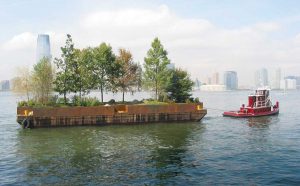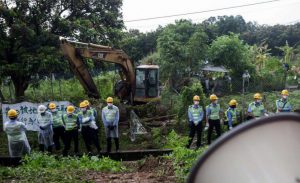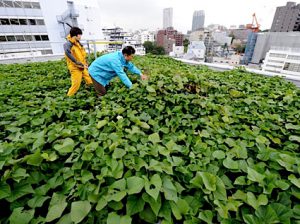|
Re-define Local Agriculture: Floating Farmland
The waters is an alternative “land”

Fig1. Floating Island Project by New York design firm Balmori
WHY?
Hong Kong’s agriculture industry has gone into a decline since the 80s. According to statistics of the Government, area of designated agricultural land and active farmland has dropped by 25% and 67% respectively over the last 20 years.1 What is more, abandoned and fallow ones actually account for a majority of the total agricultural lands in recent years (84% out of 4523 hectare in 2013).2
Coupled with expansion of international trade and market-driven economy, heavy reliance on import of food supply has brought huge challenge to local agricultural industry in terms of price and variety. Furthermore, this dependency would result in uncontrollable price inflation as well as increasing risk of supply stability and food safety, especially with more frequent extreme weather and natural disasters in this day and age. In contrast to 50% of Shanghai and 10% of Singapore, Hong Kong’s 2% self-sufficiency of vegetable supply seems to put herself at risk.3 Even though it is unrealistic to aim for full self-sufficiency in current circumstance, increasing local agricultural production is a must.
Interestingly, some see this issue as a great opportunity. Number of people interested in joining the industry actually increases. In accordance to the Agricultural Land Rehabilitation Scheme, which helps identify suitable agricultural lands and provide technical support, the Agriculture, Fisheries and Consecration Department rehabilitated about 0.6 hectare (size of ~13 basketball courts) in 2014. Still, there were 272 applicants on the waiting list while expected waiting time would be 5 years.4
In fact, one of the largest resistances of the rehabilitation is the potential high land value. Nearly 70% of land zoned as “Agriculture” is privately owned.5 Instead of renting out farmlands for long-term agricultural purpose, landowners generally prefer to either hoard or convert them into temporary outdoor storage/ scrap field for their foreseeable high monetary value due to urban development plan. For instance, similar to the previous case of Ma Shi Po farmland, 150 hectare of certificated organic farmland in Kam Tin is now under threat of resumption because of the latest North East New Territories Development Plan.6

Fig2. Redevelopment of Ma Shi Po farmland sparked protests from villagers
In short, local agriculture as an industry is diminishing in term of land availability and productivity under the threat of more profitable land use and urban sprawl. Nevertheless, it is necessary to retain the agricultural sector for self-sufficiency and economic diversity from dominating real-estate development. What is the way out of local agriculture? How should it be positioned in the society?
WHAT?
Indeed, agriculture shall not be accessed solely as a pure economic activity. Besides basic food supply, agriculture and farmland have multiple values and functions. Globally, many cities have actively engaged in retaining farmland and re-defining agriculture with new social, economic and environmental identity. For example, urban agriculture in Japan utilizes existing leftover urban surfaces. Beyond food production, it create city comfort with greenery and lower urban temperature. Also, it plays an important role in drawing youngsters’ interest in farming/food production and transmit cultural heritage. This kind of agriculture-related social activities and economy have been on a rise in Hong Kong. Weekend market, holiday farm and eco-tourism of local agriculture do improve interaction between city and rural area as well as contribute to social welfare.

Fig3. Roof-top Potato Farm in Tokyo
With the current constraint of highly profitable land development, there is a need for alternative “land” for agriculture to sustain and survive. Instead of costly and contaminating reclamation, free water surface/waterfront with few restrictions of property right can be a possible way. It can free agriculture from the threat of urban sprawl and so-called limited land.
Hence, the thesis intents to investigate possibility of moving the process of food production onto water surface/waterfront as a way out to sustain both the industry and culture of agriculture. Through the change of its social-economic and spatial relationship with the urban fabric and soil, new identities of agriculture can be explored and found.
HOW?
First, the project will start to look for potential sites/waterfronts in a larger scale according to features like water quality and surrounding urban characteristics through method of mapping. In the current city layout and planning, farmlands are somehow hidden from the crowd. The project might go into a direction of twisting this situation by making the floating farmland at least visually accessible from and influential to the city.
Second, in a smaller scale, it would be great to broadly explore various systems and relationships going on within the farm, like irrigation method. Other than traditional farming on soil, water farming and other floating farms can be something interesting to be go through. Feasibility on day-to-day basis is important, and so it would be necessary to ask questions like: what food to be produced, how the irrigation system work, way to acquire adequate water and power. Additionally, for the floating system, fishery raft of the local fishermen could be be referenced.
Last but not least, study of sustainability as well as its long-term development would be carried out. Would it be a self-cooperation operation by farmers which allows the floating farm/ community to flexibly expand and grow with a bottom-top approach?
Precedent
Traditional floating farms, Bangladesh
Smart Floating Farms, by Javier F. Ponce
Drijvend Pavilion, in Rotterdam, by Public Domain Architect
Netherlands Pavilion World Expo 2000, in Hanover, by MRVDV
Hope Waters Dome, in Jamaica, by Dinesh Ram
Green Float, In Japan, by Shimizu Operation
Bibliography
1. Agriculture, Fisheries and Conservation Department. 2014. Consultation Document: New Agricultural Policy: Sustainable Agricultural Development in Hong Kong.http://www.fhb.gov.hk/download/press_and_publications/consultation/141229_f_agricultural/e_consultation_document.pdf.
2. Legislative Council. 2015. LCQ16: Sustainable Development of Local Agriculture Annex 1. http://gia.info.gov.hk/general/201501/21/P201501210568_0568_140947.pdf
3. Agriculture, Fisheries and Conservation Department. 2014. Consultation Document: New Agricultural Policy: Sustainable Agricultural Development in Hong Kong. http://www.fhb.gov.hk/download/press_and_publications/consultation/141229_f_agricultural/e_consultation_document.pdf.
4. Legislative Council. 2014. LCQ12: Development of Local Agriculture Press Releases. http://www.info.gov.hk/gia/general/201410/29/P201410290751.htm
5.Legislative Council. 2013. LCQ10: Local Farming Industry Development Press Releases. http://www.info.gov.hk/gia/general/201306/26/P201306260312.htm
6.Chan, Yuen Lam, “Resumption of Organic Farm in Kam Tin,” Oriental Daily, 10 October 2014. http://orientaldaily.on.cc/cnt/news/20141010/00176_097.html
Fig.1. Hirsch, Jesse, “Floating Farms,” Modern Farmer. 19 March 2014. http://modernfarmer.com/2014/03/floating-farms/
Fig.2. Siu, Phila, “Developer seeks end to Fanling Land Dispute,” South China Morning Post, 28 April 2016. http://www.scmp.com/news/hong-kong/education-community/article/1939620/developer-seeks-end-fanling-land-dispute
Fig.3. Levenston, Michael, “Tokyo – Rooftop and Underground Urban Farming Lures Young Japanese Office Workers,” City Farmer News. 5 Novermber 2008. http://www.cityfarmer.info/2008/11/10/tokyo-rooftop-and-underground-urban-farming-lures-young-japanese-office-workers/
|